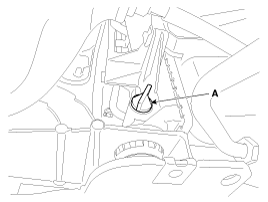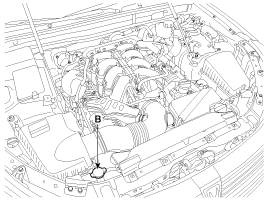 Hyundai Equus: Coolant Repair procedures
Second generation VI (2009–2025) / Hyundai Equus VI 2009-2025 Service Manual / Engine Mechanical System / Cooling System / Coolant Repair procedures
Hyundai Equus: Coolant Repair procedures
Second generation VI (2009–2025) / Hyundai Equus VI 2009-2025 Service Manual / Engine Mechanical System / Cooling System / Coolant Repair procedures
Second generation VI (2009–2025) / Hyundai Equus VI 2009-2025 Service Manual / Engine Mechanical System / Cooling System / Coolant Repair procedures
| Engine Coolant Refilling And Bleeding |
Never remove the radiator cap when the engine is hot. Serious
scalding could be caused by hot fluid under high pressure escaping from
the radiator. |
When pouring engine coolant, be sure to shut the relay box
lid and not to let coolant spill on the electrical parts or the paint.
If any coolant spills, rinse it off immediately. |
| 1. |
Make sure the engine and radiator are cool to the touch. |
| 2. |
Loosen the drain plug (A) and drain the engine coolant. Remove the radiator cap (B) to speed draining.
|
| 3. |
Tighten the radiator drain plug securely after draining engine coolant. |
| 4. |
After draining engine coolant in the reservoir tank, clean the tank. |
| 5. |
Fill the radiator with water through the radiator cap and tighten the cap.
|
| 6. |
Start the engine and allow to come to normal operating
temperature. Wait for the cooling fans to turn on several times.
Accelerate the engine to aid in purging trapped air. Shut engine off. |
| 7. |
Wait until the engine is cool. |
| 8. |
Repeat steps 1 to 7 until the drained water runs clear. |
| 9. |
Fill fluid mixture with coolant and water (55~60%) (except
for North America, Europe and China : 45~50%) slowly through the
radiator cap. Push the upper/lower hoses of the radiator so as bleed air
easily.
|
| 10. |
Start the engine and run coolant circulates.
When the cooling fan operates and coolant circulates, refill coolant through the radiator cap. |
| 11. |
Repeat 10 until the cooling fan 3~5 times and bleed air sufficiently out of the cooling system. |
| 12. |
Install the radiator cap and fill the reservoir tank to the "MAX" line with coolant. |
| 13. |
Run the vehicle under idle until the cooling fan operates 2~3 times. |
| 14. |
Stop the engine and wait coolant gets cool. |
| 15. |
Repeat 9 to 14 until the coolant level doesn't fall any more, bleed air out of the cooling system.
|
 Cooling System
Cooling System
...
 Radiator Components and Components Location
Radiator Components and Components Location
Components
1. Cooling fan assembly2. Radiator lower hose3. Radiator upper hose4. Coolant reservoir tank5. Radiator6. Mounting insulator7. Mounting bracket
...
See also:
Sunglass holder
To open the sunglass holder, press the cover and the holder will slowly open.
Place your sunglasses in the compartment door with the lenses facing out. Push to
close.
WARNING
Do not keep ...
Schematic Diagrams
ESP Circuit Diagram
ESP Connector Input/Output
[Standard]
[Premium]
Connector TerminalSpecificationPin NoDescriptionStandardPremium2931IGNITION1(+)High level of wake up voltage : 4.5V < ...
Cup holder
WARNING - Hot liquids
Do not place uncovered cups of hot liquid in the cup holder while the
vehicle is in motion. If the hot liquid spills, you could be burned. Such a
burn to the driver cou ...
Categories
Hyundai Equus Manuals
© 2011-2025 Copyright www.heqmanual.com





